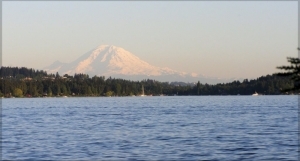Lake Washington has year around fishing opportunities.
Lake Washington is a large freshwater lake adjacent to the city of Seattle. It’s the largest lake near Seattle and the second largest natural lake in the state of Washington, after Lake Chelan.
The lake is bordered by the cities of Seattle on the west, Bellevue and Kirkland on the east, Renton to the south and Kenmore to the north. Mercer Island is situated in the south end of the lake. In addition, the lake is fed by the Sammamish River at its north end and the Cedar River at the south.
Fishing Opportunity
- Coastal Cutthroat Trout
- Kokanee
- Largemouth Bass
- Smallmouh Bass
- Yellow Perch
- Black Crappie
- Brown Bullhead
- Carp
- Chinook Salmon
- Coho Salmon
- Sockeye Salmon
- Green Sunfish
- Rainbow Trout
Ridge to River Outdoors provides fishing opportunities for smallmouth bass, with the occasional largemouth.

Fishing is done by both bank and boat, but the best fishing can be had primarily by boat.
The WDFW fishing regulations govern this lake, subsequently, not all fish species listed above may be retained. Therefore, opportunities for Chinook, Coho, and Sockeye salmon may be available; depending on the abundance of returning adults.
Boat ramps for the lake are at Kenmore, Magnuson Park at Sand Point, Gene Coulon Park in Renton, and Rainier Beach Park in Rainier Beach.
Numerous fishing piers dot the perimeter of the lake. In addition, some of the more popular piers near Kirkland are located in Waverly Park, Marina Park and at the Old Ship Museum Park.
Near Renton, Gene Coulon Memorial Park offers public fishing piers, likewise a fishing pier is available in Seward Park on the south west side of the lake. On the other hand, at the north end of Mercer Island, Luther Burbank Park offers a finger pier and boat docks for fishing.
Facts
- Lake Washington received its present name in 1854 after Thomas Mercer suggested it be named after George Washington, as the new Washington Territory had been named the year before.
- Prior to the construction of the Lake Washington Ship Canal in 1916, the Sammamish was the primary source of water for Lake Washington.
- Before construction of the Lake Washington Ship Canal in 1916, Lake Washington’s outlet was the Black River, which joined the Duwamish River and emptied into Elliott Bay.
- Subsequently, the creation of the ship canal lowered the water level of Lake Washington by 8 feet, which slightly increased the flow of the Sammamish River.
- As part of the ship canal project, the Cedar River was diverted into Lake Washington, and it is now the primary source of water for Lake Washington.
- Concrete floating bridges are employed to span the lake because Lake Washington’s depth and muddy bottom prevented the emplacement of the pilings or towers necessary for the construction of a causeway or suspension bridge. The bridges consist of hollow concrete pontoons that float atop the lake, anchored with cables to each other and to weights on the lake bottom.




